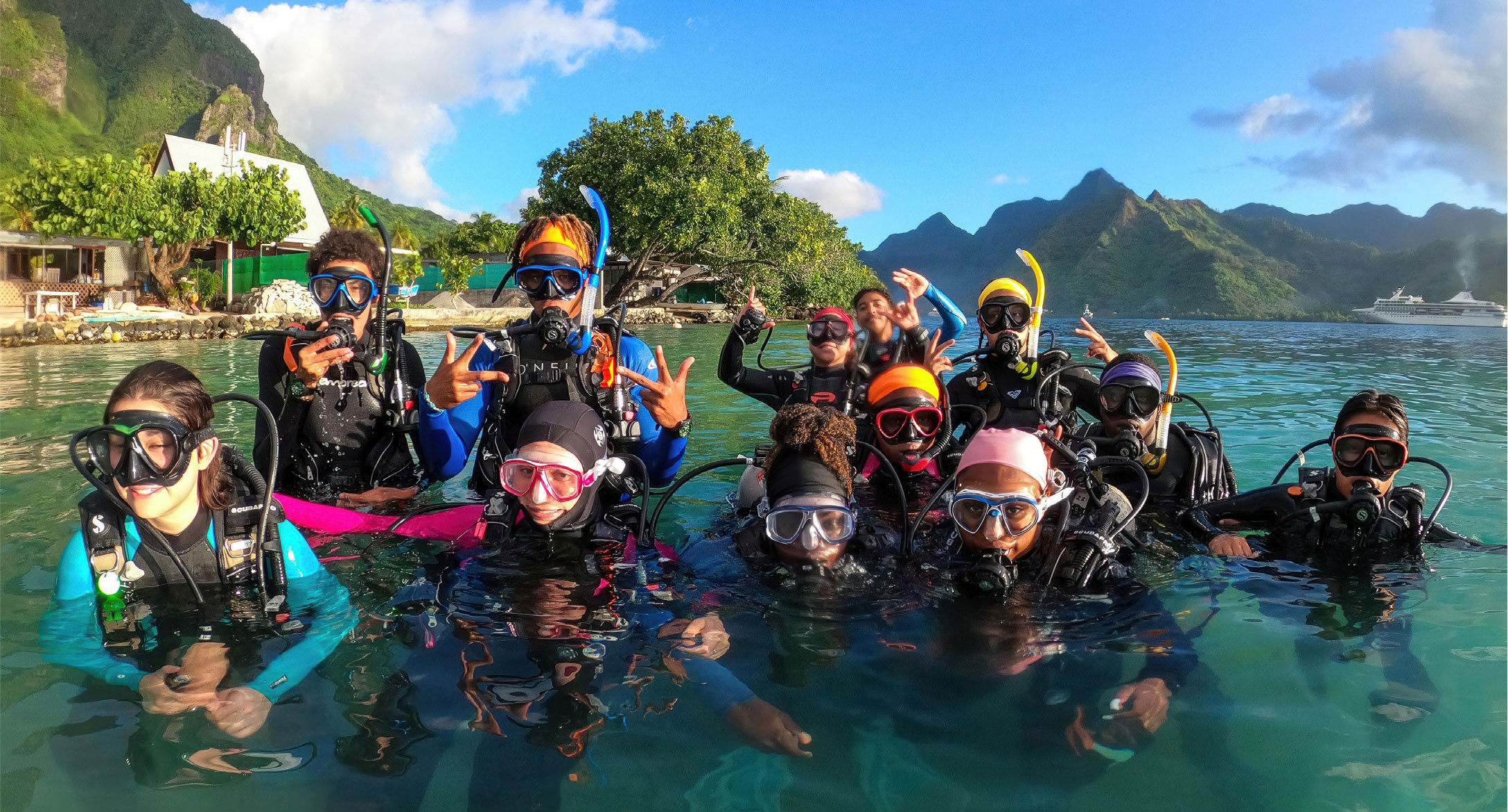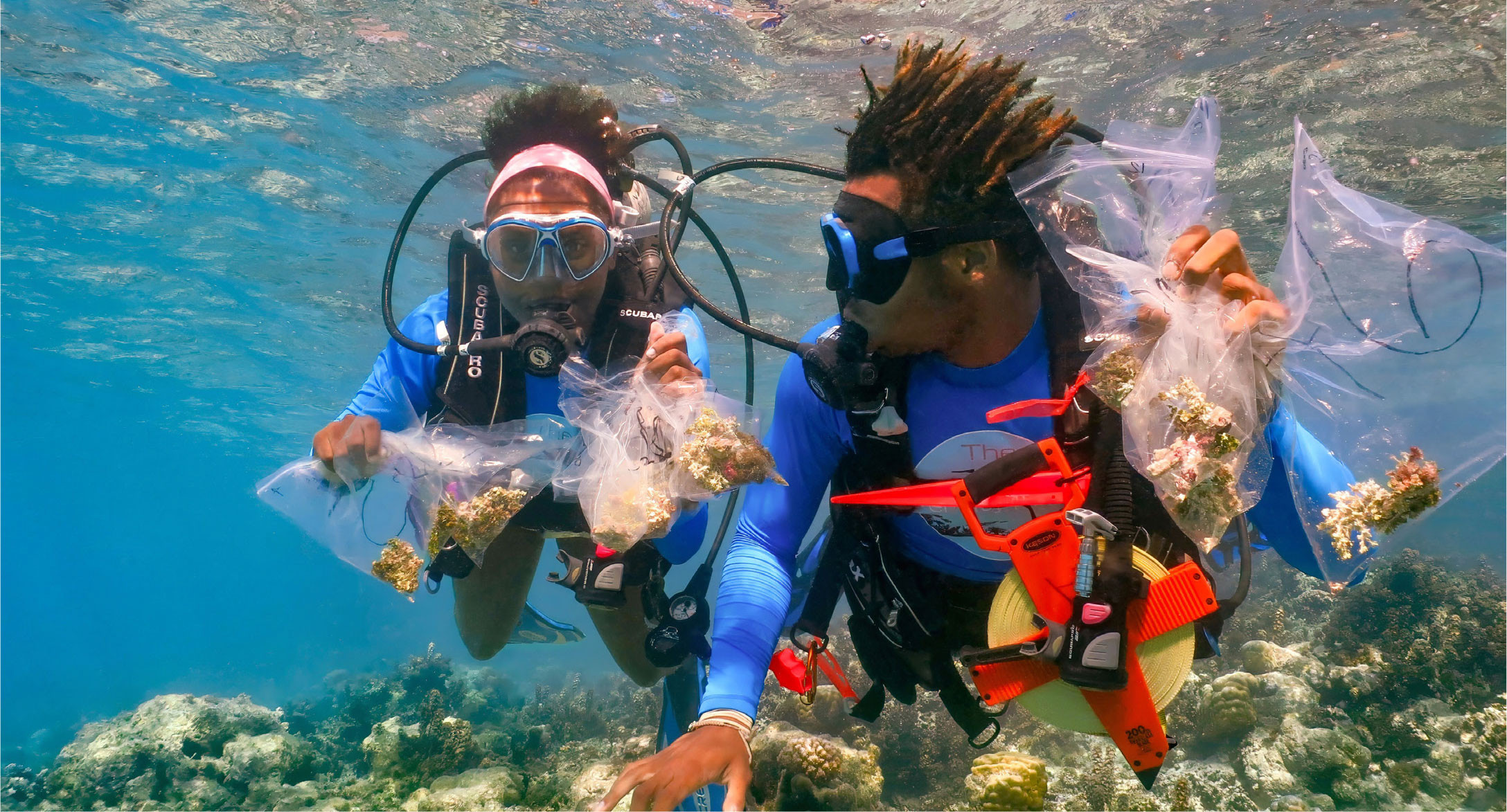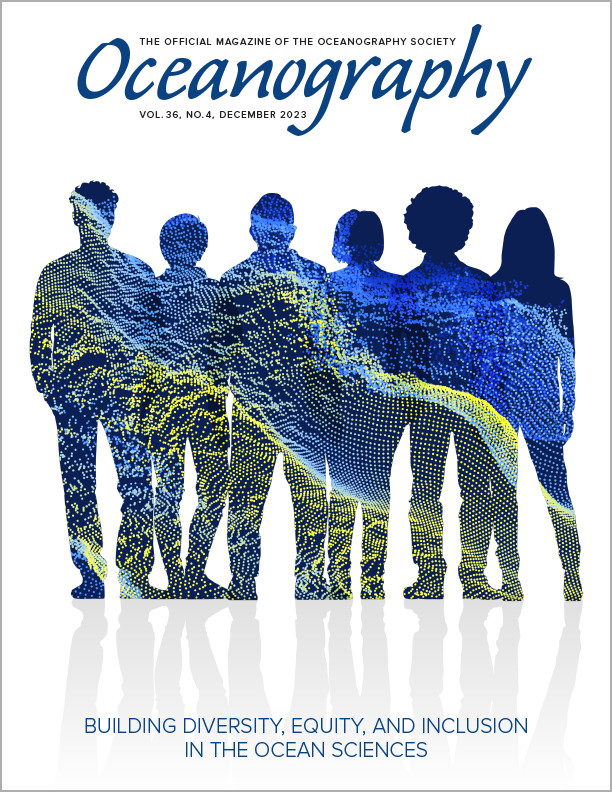Introduction
The marine sciences span a broad range of disciplines, including biological, chemical, geological, physical, computational, data, ecological, environmental, geospatial, and social sciences. Research in many of these disciplines relies on platforms such as ships to deploy technologies for gathering data that do not require scientists to physically enter the ocean or use data that can be collected using satellite sensors or other airborne vehicles. However, for some disciplines, direct observations or manipulations are essential for research, and in these fields, a commonly employed method for data gathering is diving with scuba (self-contained underwater breathing apparatus).
When scuba is used as a research tool, formal scientific diving training is often required. In the United States, this training is typically conducted under the auspices of the American Academy of Underwater Sciences (AAUS), which was formed in 1977 with the mission to “advance and facilitate safe and productive scientific diving.” As of 2023, there were 163 active AAUS organizational members (AAUS, 2023), including universities, government agencies, public aquaria, conservation organizations, and marine labs. Conducting scuba-based research within these organizations requires AAUS scientific diving certification, so this certification is critical for aspiring marine scientists working in fields where scuba is used as a research tool. Two key barriers to AAUS scientific diving certification disproportionately impact people of color, limiting diversity in the scientific diving community.

The Diversity Project 2022 cohort during American Academy of Underwater Sciences (AAUS) scientific dive training in Moorea, French Polynesia. Photo credit: Kimo Morris. > High res figure
|
Obvious Barrier to Participation in Scuba-Based Research: Financial
One prerequisite to AAUS training is basic open-water scuba certification (AAUS, 2019), which must be obtained from one of the organizations that certify recreational scuba divers (e.g., National Association of Underwater Instructors, Professional Association of Diving Instructors, Scuba Schools International). Certified recreational divers in the United States tend to be from households that are headed by college graduates (66%) and who are homeowners (99%); more than half earn more than $150,000 per year, and ~87% earn more than $75,000 per year (DEMA, 2023). These socioeconomic characteristics combined with race-based disparities in average income in the United States—Whites earn 63% more than Blacks and 35% more than Hispanics (US Census Bureau, 2021)—result in substantial disparities in participation in scuba diving, with the vast majority of certified divers being White (77%), and only 8% African American and 8% Hispanic (DAN, 2015).
The economic disparities impacting entry to recreational scuba diving extend to undergraduate populations that aspire to marine science careers that use scuba. Black (47.9%) and Hispanic (37.5%) students are much more likely to receive Pell grant support than White students (20.7%), indicating significant financial need (Kelly et al., 2019). Thus, the prices of basic scuba certification (typically between $500 and $800) and scuba equipment (between $2,000 and $3,000) are prohibitive for many. Moreover, because few universities teach scuba or AAUS scientific diving as formal academic courses, this training is not covered by financial aid and must be paid out of pocket, in addition to competing with other student coursework as well as home and work obligations.
Hidden Barrier to Participation in Scuba-Based Research: AAUS Swim Test
Although the financial barrier of scuba training is acknowledged through various scholarships offered to support it (Rosier, 2023), a significant, yet overlooked, barrier to scientific scuba diving training is the AAUS swim test. Required swim test skills include: (1) swimming 400 yards (366 meters) in 12 minutes or less, (2) swimming 25 yards (23 meters) underwater without surfacing, (3) treading water for 10 minutes, and (4) towing an adult diver 25 yards (23 meters) on the water’s surface, all without the use of swim aids such as fins. AAUS standards mandate passing a swim test prior to beginning AAUS training, and in some programs, students only have one opportunity to pass to continue with the training.
For individuals who grew up taking swim lessons or were competitive swimmers, the AAUS swim standards are manageable, but can still be challenging. For those without extensive swim training, the AAUS swim test can represent a significant obstacle and one that disproportionately impacts people of color. Due to discriminatory policies that excluded people of color from pools and beaches (Waller and Bemiller, 2018), Black and Latina/o children participate in swimming lessons at rates ~50% to 30%, respectively, lower than White children (Rajeh et al., 2023) and are 35 and 15 times less represented, respectively, in competitive swimming (USA Swimming, 2021). Therefore, the AAUS swim test is more likely to be a barrier for students of color, contributing, at least in part, to the exceptionally low representation of Black and Latina/o individuals in the ocean sciences.
Unlike financial barriers that can be overcome by funding, the swim test is a less recognized and potentially more difficult barrier to overcome. In the AAUS, as well as other scuba certification associations, the swim test is an important measure of water safety, and given the risks of working in the ocean or other bodies of water, safety is paramount. However, less demanding swim tests do not necessarily compromise safety. The AAUS swim test differs from other scuba certification agencies. For example, the largest certification agency in North America, the Professional Association of Diving Instructors (PADI), requires an untimed 200-meter surface swim and a 10-minute survival swim/float (PADI, 2023). Despite these different requirements, recreational scuba fatality rates in the United States and Canada are still extremely low (1.8 per one million recreational dives; Buzzacott et al., 2018), similar to fatality rates for driving a car or jogging (Denoble et al., 2011).
The AAUS swim test was developed arbitrarily, based on early scuba training and military standards. The 400-yard (366-meter) swim is the approximate distance around the pier at the Scripps Institution of Oceanography, and the 25-yard (23-meter) underwater swim is the approximate distance it takes to swim through the breaking waves at the Scripps pier; it is also a common distance of lap pools. No data support that a diver who completes a 400-yard swim in 12 minutes is safer than one who completes it in 13 minutes, or that a diver who can only swim 20 yards (18 meters) underwater, on one breath, is less safe than one who can complete 25 yards. In fact, detailed examination of scuba accidents, including fatalities, shows that most dive accidents result from poor planning, poor decisions, and panic (Ange, 2005) rather than how fast or far a diver can swim.
Toward a More Inclusive Model of Research Dive Training
Overcoming Financial Barriers
Historically, many colleges and universities offered basic scuba training as a course, and some offered AAUS scientific diving training as well. Some institutions still do. For example, California State University Monterey Bay offers four different scuba courses, from basic scuba training to scientific diving. By offering this training as credit-bearing courses, students can use financial aid to help cover the costs, and they also don’t have to take scuba training in addition to all of their other courses because it is one of their courses, particularly if these units count toward their degree.
The shift from scuba training as a credit-bearing class to an extracurricular activity is likely the result of institutional cost cutting, transferring the cost of dive safety training from the institution to students. However, scientific diving training is safety training and should be treated as such. Institutions do not have students bear the cost of laboratory, radiation, or laser safety training, and doing so would exclude lower socioeconomic status students who disproportionately come from underrepresented groups. Typical lab safety classes are not offered for academic credit as they only take a few hours compared to the weeks needed for scuba. However, approaching dive training as safety training, but teaching it in the context of a formal academic courses that count toward degree requirements, would greatly increase opportunities for students of color to participate and open pathways to careers in marine science.
Similarly, mechanisms are needed for mitigating the cost of equipment required for basic and scientific diving training. Introductory molecular biology labs maintain a variety of equipment, from PCR machines to centrifuges, pipettors, and power supplies. Chemistry labs have spectrophotometers, precision scales, chemical fume hoods, and a wide range of glassware and chemicals. Whether biology, chemistry, or physics, the costs of maintaining these labs are viewed as normal educational expenses, sometimes offset with modest laboratory fees. No institution would expect students to front $2,500–$4,000 (training + equipment costs) to participate in a chemistry or molecular biology lab, yet this is standard practice for scientific diving training.
Colleges and universities should maintain a stock of equipment that can be used by students going through basic and scientific scuba training, just as they do for other scientific disciplines. This simple step would make dive training much more accessible for low-income students, who are disproportionately students of color. To that end, Hampton University’s Department of Marine and Environmental Science (MES) and the aquatics department are pairing up to offer swimming courses for all MES students in the fall semester, and scuba lessons, free to students, in the spring semester. The swimming lessons will satisfy a physical education credit and the scuba training is supported by funding from the MES chairperson, which will pay for the training and basic equipment required. This pilot program will bring back the scuba program that thrived at Hampton University in the 1990s.
An Inclusive Approach to Evaluating Water Safety
In the ocean, panic kills. It is therefore essential to develop competent, strong, and confident divers so that they can respond appropriately and calmly to potentially life-threatening situations. However, being able to complete current AAUS swim test standards does not ensure confidence and safety in the water, and it is possible to be confident and safe in the water while falling short of them.
The AAUS has a strong safety record, with a rate of decompression illness that is three to ten times lower than that of the recreational dive community (Dardeau et al., 2012). This record is likely due to the many additional hours of training (e.g., minimum 100 hours of theoretical and practical training) and oversight (Dardeau et al., 2012) rather than to the swim test. Additionally, initial AAUS certification depths are limited to 30 feet (9 meters), where decompression illness is less likely. There are alternative models that could foster diver confidence in the water, while reducing barriers to entry that disproportionately affect aspiring Black and Latina/o marine scientists. Potential models include:
1. MINOR CHANGE: Integrate development of swim skills into the AAUS training, while allowing use of snorkeling equipment
Building skill development into AAUS training rather than making it a prerequisite would give weaker swimmers more time to develop their water skills and confidence during the pool-based portions of training. Similarly, the standards could be changed to allow these skills to be performed with a mask, snorkel, and fins. We can think of no realistic emergency situations where a diver would remove all their gear prior to swimming to safety. These two small changes would make it more likely that students would begin AAUS training and pass the current requirements for the swim test by the end of training rather than at the point of entry.
2. MODEST CHANGE: Restructure the swim test
Eliminate the 12-minute time limit on the 400-yard (366-meter) swim, focusing instead on completing the swim, at any pace, comfortably, and confidently. Reduce the underwater swim distance to 30 feet (9 meters), or even 50 feet (15 meters). Newly certified AAUS divers have a depth limit of 30 feet (9 meters), so this represents the maximum distance a diver would need to ascend during an emergency out-of-air situation. As diver depth ratings increase, so too could the distance of the underwater swim test.
3. ASPIRATIONAL CHANGE: Re-envision the swim test
Practice develops diver confidence in the water, reduces likelihood of panic, and increases diver safety. The 100 hours of mandatory training required for AAUS certification is a critical part of developing this confidence and reducing dive accidents. Rather than the current swim test that evaluates swimming skills and technique as a proxy for diver confidence and safety in the water, a water confidence test could instead include real-world situations, such as a 400-yard (366-meter) surface swim in full scuba gear or simulated out-of-air situations where divers swim 20 feet (6 meters) to initiate buddy breathing. These self-rescue skills would complement currently required skills, such as the emergency swimming ascent. Such skills would develop divers’ confidence in their ability to respond to an emergency, reduce the likelihood of panic, and increase diver safety.
The key to all three proposed changes is acknowledging the need for flexibility, given that training and work environments vary. For example, if training environments require entry through strong surf, entry-level swim skills may need to be higher than if training is in a calm bay or lagoon. Similarly, if divers are working in more challenging conditions (e.g., strong currents), they may need to demonstrate appropriate skills prior to being added to the dive plan. The fact that more challenging conditions exist shouldn’t require entry-level scientific divers to have the skills to handle those conditions at the start of their training.

Maddi Stewart and Cameron Cooper collect algal samples for their research project that employs trait-based ecology to understand the impacts of herbivory on marine algae. Photo credit: Paul Barber and Kimo Morris. > High res figure
|
The Diversity Project: A Successful Model
Founded in 2005, The Diversity Project (TDP) is a 10-week research-intensive summer program that, since 2010, has included basic and AAUS scuba training as part of the program. Almost all students who participate in TDP are Black or Latina/o, and many who are accepted into the program are weak or non-swimmers. As a result, TDP takes a holistic and inclusive approach to AAUS dive training, with several simple and effective modifications that could be incorporated broadly into scientific diving training.
First, we maintain a small dive locker with sufficient equipment to provide every participant with a buoyancy compensator, a regulator, and a dive computer for use during the project. We also use grant funds to purchase personal snorkeling gear (wet suit, mask, snorkel, fins) for every student, eliminating a key financial barrier to scuba training. Second, we encourage and support students who cannot swim to take lessons prior to the program, and we work with less-experienced swimmers in the pool to develop their water skills. For example, we encourage our students to go swimming a few times a week prior to the start of the program, send them links to YouTube tutorials on improving underwater swimming skills, coach them in the pool prior to the swim test, and incorporate games that build water skills (e.g., “sharks and minnows,” a game of tag where swimmers can only be tagged while on the surface, thus encouraging swimming as long as possible underwater). Third, we integrate water skills development into our scuba training, allowing students to increase their comfort in the water. For example, we have students collect coral rubble and then spell out “Happy Father’s Day” on a sand flat, all on snorkel, to create a video they can share with their parents. From the student perspective, this is just a fun exercise, but from a training perspective, it develops student confidence and capacity for breath-hold diving. Lastly, we allow students multiple attempts during the program to complete the swim test skills, providing one-on-one coaching, as needed, to ensure they succeed. As a result, even though the vast majority of our students were not competitive swimmers, and often lack perfect swimming technique, all students who wanted to complete the AAUS training successfully have earned their scientific diving certification, including many who could not complete all skills on day one. And, with the exception of providing students with their own personal equipment, all of these modifications can be done for no, or limited, cost, increasing accessibility of scientific diving training to students of color. Most importantly, to date, the program hasn’t experienced a single scuba accident or injury, and many of our alumni have continued on to graduate school and marine science careers.
Concluding Remarks
Increasing the participation of Black, Latina/o, Native American, Native Alaskan, and Pacific Islander professionals in marine science—beyond the paltry current 4% level, requires identifying and removing as many barriers to entry as possible. Safety dictates that anyone engaged in scuba can swim and is safe and comfortable in the water. Given racial disparities in drowning rates (Clemens et al., 2021), some institutions, such as Howard University (a historically Black university), require swimming proficiency for graduation. Although this may be impractical for many institutions, they should, nonetheless, work toward advancing universal swimming proficiency by providing access to swim training, especially where there are scientific diving programs.
In addition to promoting swim proficiency, we could do more to increase access to careers in marine science. Small modifications to current approaches to scientific diving training, including those employed by The Diversity Project, could also substantially reduce both financial and swimming related barriers to entry and increase diversity and inclusivity in scientific diving, without compromising safety. These proposed modifications to how we train science divers is simple and easily achievable, and will open the doors for more aspiring marine scientists of color to pursue scientific diving training, providing them with a vital skill for future careers in marine science.



